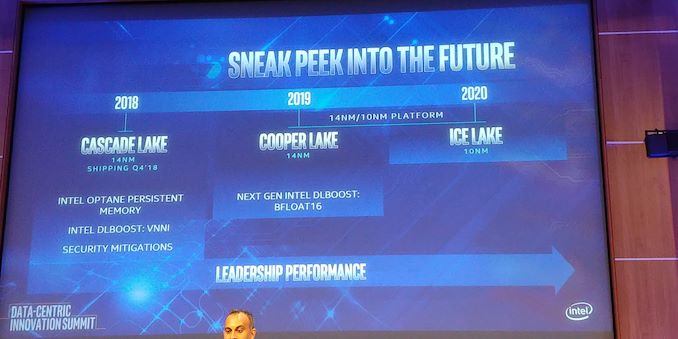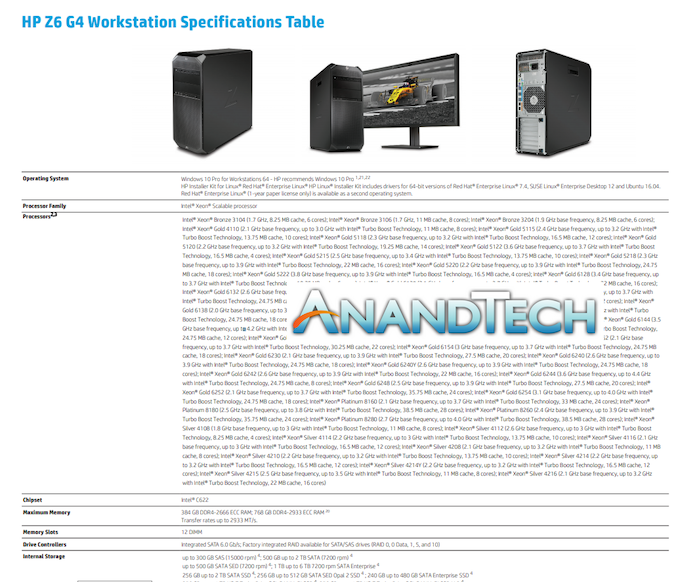Some Cascade Lake Xeon Scalable Processor Specifications Exposed in SI Documents
by Ian Cutress on February 23, 2019 4:15 AM EST
The next generation of Intel’s server processor line is the Cascade Lake Xeon Scalable family. Intel has been promoting it as the next generation over several events through 2018, and we are patiently awaiting its launch sometime in 2019. It would appear that one of Intel’s partners has already jumped the gun, publishing a partial list of parts Intel will be releasing in relation to one of its systems. This part list goes all the way from six-core Xeon Bronze all the way up to 28-core Xeon Platinum.
Over the course of 2018, Intel announced at its Data Center summit that the next generation of Cascade Lake Xeon Scalable processors would follow the current generation of Skylake Xeon Scalable parts, and would include hardware protections for some of the Spectre/Meltdown vulnerabilities as well as support for VNNI instructions and Optane DC Persistent Memory. Originally listed as shipping in Q4 2018, which in Intel’s case means ‘shipping for revenue to select customers’, we are expecting the general launch of Cascade Lake Xeon Scalable to happen in the March-to-May timeframe, based on one of the partners who happened to mention as much at Supercomputing.
Aside from details about the chip, we are also waiting on the official specifications and which SKUs Intel is planning to bring to market. Thankfully, one of Intel’s partners has released a document detailing one of its current market commercial workstation systems which has been upgraded to show both compatible Skylake and Cascade Lake processors.
From this we can get a breakdown of a good portion of the intended Xeon Scalable processors coming to market. On the left we have the offerings for Skylake, and on the right is the replacement in Cascade Lake. Increases are highlighted in green.
| Intel Cascade Lake Xeon Scalable Processors (as exposed in Partner Documents) |
|||||||||||||
| Skylake | Cascade Lake | ||||||||||||
| Platinum 8000 | Platinum 8000 | ||||||||||||
| Name | Cores | Base | Turbo | L3 | Name | Cores | Base | Turbo | L3 | ||||
| 8180 | 28 | 2.5 | 3.8 | 38.50 | 8280 | 28 | 2.7 | 4.0 | 38.50 | ||||
| 8160 | 24 | 2.1 | 3.7 | 33.00 | 8260 | 24 | 2.4 | 3.8 | 35.75 | ||||
| Gold 6000 | Gold 6000 | ||||||||||||
| Name | Cores | Base | Turbo | L3 | Name | Cores | Base | Turbo | L3 | ||||
| 6154 | 18 | 3.0 | 3.7 | 24.75 | 6254 | 18 | 3.1 | 4.0 | 24.75 | ||||
| 6152 | 22 | 2.1 | 3.7 | 30.25 | 6252 | 24 | 2.1 | 3.7 | 35.75 | ||||
| 6148 | 20 | 2.4 | 3.7 | 27.50 | 6248 | 20 | 2.5 | 3.9 | 27.50 | ||||
| 6146 | 12 | 3.2 | 4.2 | 24.75 | |||||||||
| 6144 | 8 | 3.5 | 4.2 | 24.75 | 6244 | 8 | 3.6 | 4.4 | 24.75 | ||||
| 6142 | 16 | 2.6 | 3.7 | 22.00 | 6242 | 16 | 2.6 | 3.9 | 22.00 | ||||
| 6140 | 18 | 2.3 | 3.7 | 24.75 | 6240 | 18 | 2.6 | 3.9 | 24.75 | ||||
| 6240Y | 18 | 2.6 | 3.9 | 24.75 | |||||||||
| 6138 | 20 | 2.0 | 3.7 | 27.50 | |||||||||
| 6136 | 12 | 3.0 | 3.7 | 24.75 | |||||||||
| 6134 | 8 | 3.2 | 3.7 | 24.75 | |||||||||
| 6132 | 14 | 2.6 | 3.7 | 19.25 | |||||||||
| 6130 | 16 | 2.1 | 3.7 | 22.00 | 6230 | 20 | 2.1 | 3.9 | 27.50 | ||||
| 6128 | 6 | 3.4 | 3.7 | 19.25 | |||||||||
| Gold 5000 | Gold 5000 | ||||||||||||
| Name | Cores | Base | Turbo | L3 | Name | Cores | Base | Turbo | L3 | ||||
| 5122 | 4 | 3.6 | 3.7 | 16.50 | 5222 | 4 | 3.8 | 3.9 | 16.50 | ||||
| 5120 | 14 | 2.2 | 3.2 | 19.25 | 5220 | 18 | 2.2 | 3.9 | 24.75 | ||||
| 5118 | 12 | 2.3 | 3.2 | 16.50 | 5218 | 16 | 2.3 | 3.9 | 22.00 | ||||
| 5115 | 10 | 2.4 | 3.2 | 13.75 | 5215 | 10 | 2.5 | 3.4 | 13.75 | ||||
| 4110 | 8 | 2.1 | 3.0 | 11.00 | |||||||||
| Silver 5000 | Silver 5000 | ||||||||||||
| Name | Cores | Base | Turbo | L3 | Name | Cores | Base | Turbo | L3 | ||||
| 4116 | 12 | 2.1 | 3.0 | 16.50 | 4216 | 16 | 2.1 | 3.2 | 22.00 | ||||
| 4215 | 8 | 2.5 | 3.5 | 11.00 | |||||||||
| 4114 | 10 | 2.2 | 3.0 | 13.75 | 4214 | 12 | 2.2 | 3.2 | 16.50 | ||||
| 4214Y | 12 | 2.2 | 3.2 | 16.50 | |||||||||
| 4112 | 4 | 2.6 | 3.0 | 8.25 | |||||||||
| 4210 | 10 | 2.2 | 3.2 | 13.75 | |||||||||
| 4108 | 8 | 1.8 | 3.0 | 11.00 | 4208 | 8 | 2.1 | 3.2 | 11.00 | ||||
| Bronze 3000 | Bronze 3000 | ||||||||||||
| Name | Cores | Base | Turbo | L3 | Name | Cores | Base | Turbo | L3 | ||||
| 3106 | 8 | 1.7 | - | 11.00 | |||||||||
| 3104 | 6 | 1.7 | - | 8.25 | 3204 | 6 | 1.9 | - | 8.25 | ||||
| AnandTech | |||||||||||||
The top of the line is a replacement to the 28-core Xeon Platinum 8180 with an 8280, which has the same number of cores but has a 200 MHz increase in base and turbo (no word on per-core frequencies, which matter more). In fact, because (as far as we understand at this point) Cascade Lake is essentially Skylake with some updates on security and instruction improvements, Intel has had little room to massively boost up the frequency across the range of processors. Having that default security in place helps a lot from a security audit perspective, and supporting VNNI/Optane is great for the customers that can use it, however we will have to wait and see if there are any other differences in the design. We also have no indication of price, which if one recent European retailer is to be believed, could mean an increase on the top end processor by almost double over Skylake, with a listing showing a retail price for an 8280L (?) of £15025.88 pre-tax, which equates to $19613, almost double the $10033 for the 8180.
We’ll wait and see for what other processors Intel plans to launch with Cascade Lake, as well as if there are any other features that have not yet been disclosed.
Related Reading
- Intel Datacenter Summit 2018 Live Blog
- Intel’s Keynote at CES 2019: 10nm, Ice Lake, Lakefield, Snow Ridge, Cascade Lake
- Documents Shed Light on Cascade Lake, Cooper Lake, and Ice Lake for Servers
- Intel Partner Discloses Cascade Lake Xeon Scalable Launch Window
- Intel Goes For 48-Cores: Cascade-AP with Multi-Chip Package Coming Soon
- Intel at Hot Chips 2018: Showing the Ankle of Cascade Lake











6 Comments
View All Comments
HollyDOL - Saturday, February 23, 2019 - link
Even after all that time the metallic naming for enterprise hardware sounds weird.BigMamaInHouse - Saturday, February 23, 2019 - link
Another Tick(8180) and Tock(8280) ;-).Supercell99 - Sunday, February 24, 2019 - link
These prices are absurd by any measure.Santoval - Sunday, February 24, 2019 - link
That doubling of price makes absolutely no sense, if it's true (which sounds too bizarre to be). Cascade Lake (X & AP) will compete against the Zen 2 based Epyc CPUs, which sport up to 64 cores. And Intel is going to sell 28-core CPUs for ~$20,000? Do they actually want to cause a massive switch to AMD in the server market? Perhaps that retailer sells a pair of 8280L for that much, though it is not specified.dgingeri - Sunday, February 24, 2019 - link
In other words, Intel has absolutely no response to Epyc, and especially not Epyc 2.Elquin - Tuesday, July 16, 2019 - link
Is there any comparison in Cascade vs Skylake. An example is what Cascade CPU would replace the Skylake 8158?